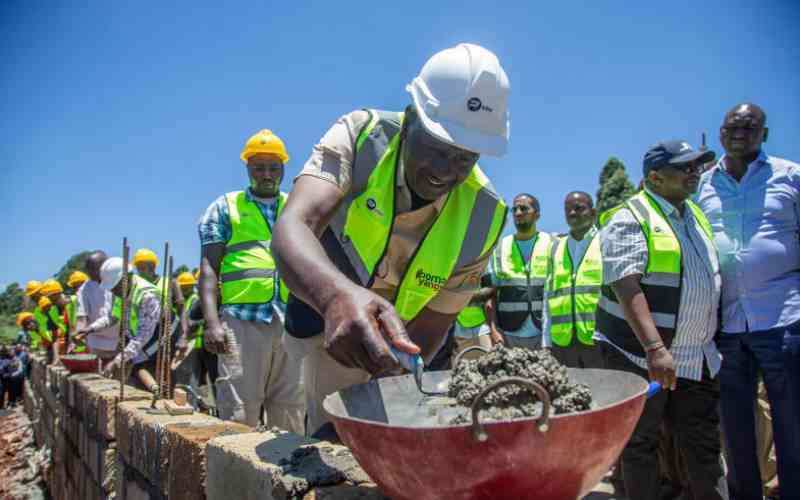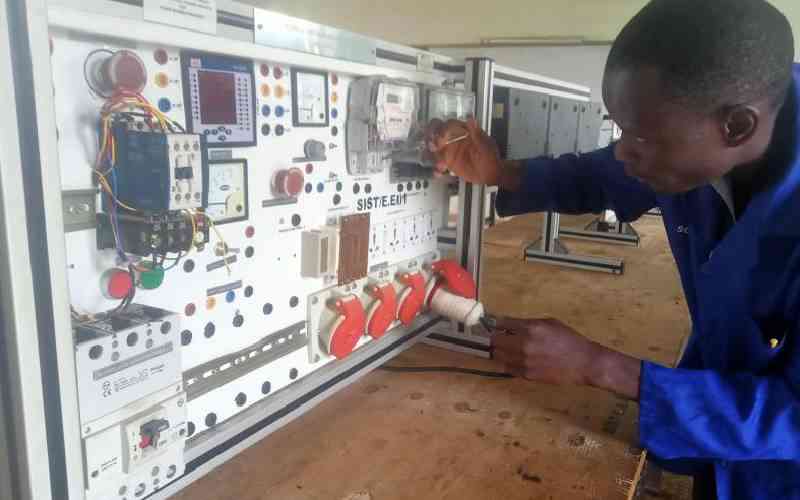BY JAMES WANZALA
With skyrocketing prices of building materials, especially sand, cement, iron sheets, bricks and stones, developers are trying to look for the alternative materials to reduce the cost of construction.
One such approach is the use of interlocking bricks. Interlocking blocks are slowly gaining acceptance, with sector players saying they bring the cost down by up to 30 per cent, compared to conventional building bricks.
While still gaining acceptance, it’s not an entirely new idea with various people having tried, with varying rates of success, to offer alternative building materials.
And today, with the high rate of inflation and cost of imported construction materials such as steel has shot through the roof and it is time to ‘think outside the box’.
“Utilising available technologies such as the interlocking stabilised soil blocks and efficient house designs can shield one from feeling the inflationary pressure during construction,” says Francis Gichuhi, an architect.
MAKING BLOCKS
The blocks can be made by manual press machines manufactured locally or motorised Hydraform ones, which are imported from South Africa.
The technology makes blocks faster as the curing process is not by firing as with the traditional method.
One advantage of the stabilised soil block presses is you can make your bricks as you build. According to Ronald Kefa, a business development director with Surelink International Ltd, which designs and constructs houses with interlocking blocks, any soil with clay content of 25-35 per cent can be used. He says that if the clay content is more than 35 per cent, you will have to blend it with river sand.
However, during the making of the blocks, black cotton soil is not recommended because it has properties, which require a lot of cement to stabilise hence ot economical.
The interlocking stabilised soil blocks are not only eco-friendly and cost-effective, but also have aesthetic appeal. They bring out a rustic natural appearance to house walling.
The type of soil determines the eventual wall colour. Whitish soil can be used to produce white coloured blocks while reddish soil can be used to produce red ones. These can be mixed together to form patterns depending on the house owner’s desire.
The interlocking blocks are cost effective; you make them on the site hence, saving costs of transportation.
“Clients come and hire us in case they have a different construction company, we come with our machines and make the number of blocks required then we leave,” says Kefa.
Stay informed. Subscribe to our newsletter
He adds: “When building with interlocking blocks, you do not need to use mortar, 85 per cent of walling is just dry staking and they also have a neat finishing that you do not require plastering unlike bricks and some quarry stones.”
The stabilised soil blocks are covered with black polythene sheet for two weeks, where they will be watered for the first one week, then left to cure during the second week, after which they will be ready for use.
COST
The cost of building with stabilised soil blocks is also lower than using iron sheets for walling or cut stones. One bag of cement produces 150 blocks with a two-bedroom house requiring approximately 40 bags of cement.
On the other hand, gauge 30 iron sheets costs around Sh400 per square metre, timber to support the structure costs an extra Sh300 per square metre.
Masonry stone walling takes 13 stones per square metre and each stone cost Sh50, adding up to Sh650. When mortar is added at Sh200 per square metre, this brings the cost to Sh850.
According to findings by Kyoto University, a structure occupying 120 square metres made from SSB, costs a third of one constructed from concrete blocks.
Other than cost benefits, the ecological aspect makes it ideal compared to burning of bricks in kilns fired using wood.
The end results of this technology are amazing and beautiful with high quality blocks, uniform in size and shape with defined edges and smooth surfaces, which makes construction easier.
Economically, however, it mobilises and empowers the communities to create infrastructure and amenities; and ownership of the machine provides long-term income generating venture for entrepreneurs.
SAVES TIME
It is also particularly suitable in areas where cement is costly and difficult to obtain. “Building with interlocking blocks saves time to put up a house since they do not need time to dry unlike other conventional masonry, a bungalow walling can be built in a day depending on the number of labourers you have,” adds Ronald.
One should also not fear for the building’s structural integrity as the blocks have the strength to carry the roof of the house since they are heavy and evenly compacted hence, eliminating reinforcement requirements.
This is in addition to thematic advantage in that the blocks are nine inch wide, so that in hot places, they keep the house cold and vice versa.
BUILDING
Note, however, that during construction, the foundation is done just like in a conventional construction, the difference comes in walling.
Blocks are dusted off or brushed before being laid to remove dirt to ensure consistency levels and perfect interlocking. The first course is laid in mortar, the rest of the courses are just dry staked up to the ring beam where you use concrete reinforcement. The first course after the ring beam are laid in mortar, then the rest of the courses are dry staked.
The blocks have female and male faces, the protruding side is the male and the non-protruding part is the female, the base is called the bed and the top is called the ridge.
During laying of the block, the bed of the block on top interlocks with the ridge of the block beneath. “When laying the blocks next to another, the male face must interlock with the female face hence, the process called interlocking,” explains Ronald.
During laying again, he adds, if the first male face of the first course is facing to the left for instance, the next face will be laid with male face facing the opposite direction.
INTERLOCKING
In every course, the male face must face the same direction to ensure consistency in interlocks hence, avoiding gaps, which can weaken the walling.
Construction must start with half blocks and from the two corners, and meet at the centre, unlike the conventional way where you can start anywhere.
In case of construction rounded or curved structures like boreholes, water tanks little mortar is needed between the gaps.
Surelink International Ltd is and has developed many structures with interlocking blocks one of them being the Valley Apartments in Nakuru opposite Bondeni Police Station with 72 units.
South Africa, is another country that has embraced this technology.
 The Standard Group Plc is a
multi-media organization with investments in media platforms spanning newspaper
print operations, television, radio broadcasting, digital and online services. The
Standard Group is recognized as a leading multi-media house in Kenya with a key
influence in matters of national and international interest.
The Standard Group Plc is a
multi-media organization with investments in media platforms spanning newspaper
print operations, television, radio broadcasting, digital and online services. The
Standard Group is recognized as a leading multi-media house in Kenya with a key
influence in matters of national and international interest.
 The Standard Group Plc is a
multi-media organization with investments in media platforms spanning newspaper
print operations, television, radio broadcasting, digital and online services. The
Standard Group is recognized as a leading multi-media house in Kenya with a key
influence in matters of national and international interest.
The Standard Group Plc is a
multi-media organization with investments in media platforms spanning newspaper
print operations, television, radio broadcasting, digital and online services. The
Standard Group is recognized as a leading multi-media house in Kenya with a key
influence in matters of national and international interest.







